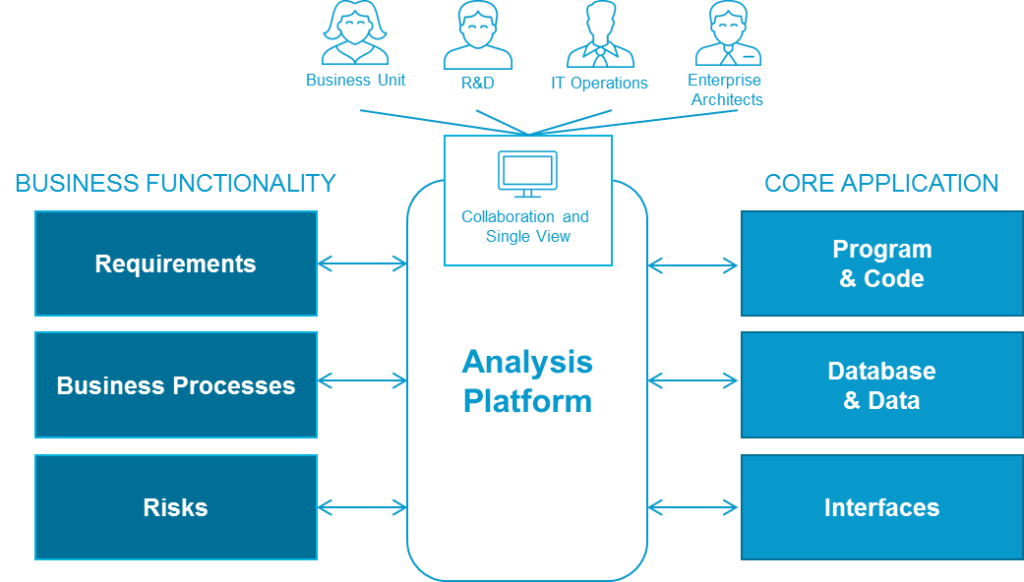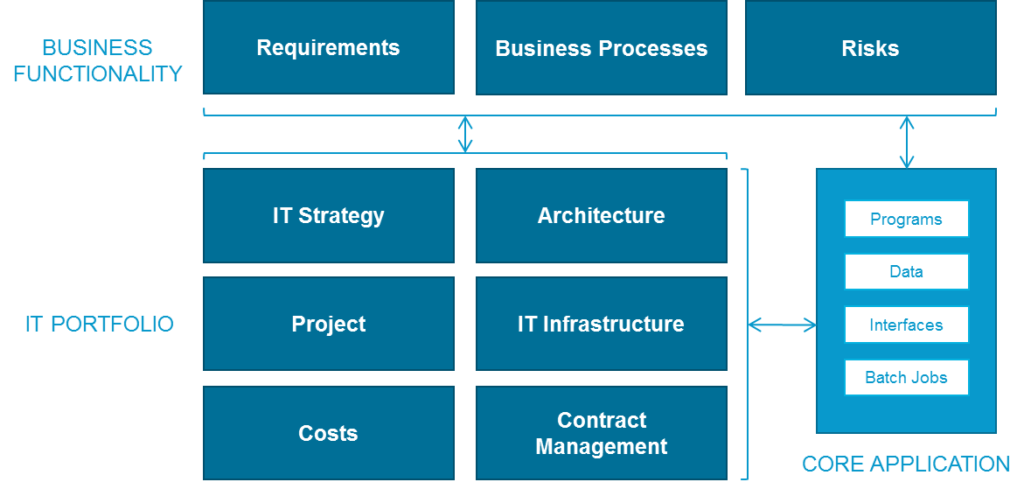How to reduce costs and provide optimal IT support for a business model. Types of business analysis
Static analysis of applications
Business logic and process logic are implemented using source code and related software structures and libraries. However, often the source code is a „spaghetti code” without a clear structure, which negatively affects the recognition and change of business logic. Natural Engineer, a tool for static analysis of applications (such as programs and data structures), allows you to accurately display the current situation. Different evaluation options will help make complex static analysis of applications more manageable.
An ideal analysis platform, such as Natural Engineer, offers the following features:
- Analysis tools for COBOL, IBM CICS tables, JCL source code, and Natural.
- Support of Adabas & Natural, COBOL, as well as other 3GL languages and features, such as various types of programming and different product versions.
- Recognition and documentation interface.
- Automatic creation of application documentation, structural diagrams (for example, control flow, decision tables), reports and impact analysis in several formats (for example, Microsoft Excel, Microsoft Word, PDF and HTML).
- Recognition of databases (e.g. Adabas, DB2), database structures, and access types.
- Complexity metrics (McCabe, Halstead).
- Detection of obsolete or redundant source code.
- Web-based tools for interactive navigation through software structures and dependencies.
Dynamic process analysis
Dynamic analysis evaluates the application transaction load at runtime, database access, user interaction, and service calls during normal operation and peak load. In case of using this analysis, you can get information about the number of the application users of over a certain period of time and the efficiency with which it processes peak loads.
The Entire Operations solution allows you to evaluate work in batch processing mode and work with entire networks of batch tasks. The processing statuses of all tasks are checked for detection and reporting of any SLA violations and a better understanding of dependencies.

An ideal analysis platform, such as Entire Operations, offers the following dynamic analysis capabilities:
- Support of interactive and batch applications.
- Diagnostics of the source code during application execution (profiling and scope of the code).
- Monitoring of production status on distributed platforms.
- Detection of critical situations through regular monitoring of system KPIs.
- Measurement and visualization of completed batch processes and determination of discrepancies in them.
- Graphical dashboards for quick and easy analytics.
Business Function Analysis
The main task of analyzing the business functionality of the main application is to establish a relationship between business elements and technical elements in order to determine which parts of the application implement specific business rules and (or) processes. Only through such correlations we can get a complete picture of the application progress and actually exchange data between the employees and the IT department.
The interface between Natural Engineer static analysis tools and business function analysis provides information about applications, programs, and relationships in a way that non-technical employees understand. It is a real basis for documenting business processes and recommendations for improvements and new opportunities.

Perfect analysis through the Natural Engineer ARIS interface and the ARIS platform offers the following features:
- Match of business processes and rules to implementation components.
- Translation of the program’s technical logic into an additional documentation format (for example, in the form of business process modeling note (BPMN)), which will be understandable and useful for business units.
- Matching of packet data with business events (business logic).
- Analysis of business processes and their implementation in order to optimize them.
- Support for collaboration between business and technology departments.
IT Portfolio Analysis
The results of the analysis of the main applications and their business functions will become the basis for conducting an inventory and analysis of the IT portfolio. An analysis of the IT portfolio will allow us to outline and evaluate business functionality, as well as applications, technologies, strategies, requirements, projects and their complex relationships with each other in order to optimize the application environment and ensure compliance with business goals.
To implement the ideal environment, is used an IT portfolio management platform such as Software AG’s Alfabet, as well as plans for implementing and monitoring compliance. Moreover, at the stages of collecting information, evaluating the portfolio and making decisions related to the portfolio, it is extremely important to apply an approach based on the use of roles and responsibilities. Those people, who are interested in managing their IT portfolio need to have reliable information about applications and their specifics. They should also have access to content, views, functions, and workflows in accordance with their roles.

In the analysis process, Alfabet’s IT portfolio management platform allows all interested parties to:
- Link business functions, applications, technologies, projects, strategies, requirements and costs.
- Define standards for documenting and evaluating projects (cost / income analysis).
- Use the results of the business application analysis and functions to optimize and align the volume of applications with the business strategy.
- Assess the impact of changes in business functions or technologies on the application portfolio.
- Create and monitor compliance with the development plan in terms of the application landscape.
- Integrate existing IT repositories and their assets.
- Customize reporting and analytics features.
- Define and configure access levels and workflows for the respective roles.
Strategic IT Transformation Planning and Modeling
The results of the applications analysis, business functions and the entire IT portfolio is a starting point for decisions that will facilitate the development of a proper plan that transforms your existing core application architecture into a future-oriented, targeted one. Effective analysis allows relevant departments to continuously monitor and manage the transformation process as needed. The possibility of parallel functioning of current and target applications during the implementation period means that the changed or added architectural elements can be evaluated at an early stage, which will significantly reduce risks and implementation time.

Your way to success
Successful transformation requires comprehensive, relevant data from the analysis. The analysis should consist of three approaches:
- Key application analysis includes static and dynamic processing methods for online and batch applications
- Analysis of business functionality using the results of the analysis described in paragraph 1.
- Analysis of IT portfolio based on the results of the analyzes described in paragraphs 1 and 2
If necessary, it is possible to provide additional studies that can be carried out in parallel with the described approach, which will allow you to achieve your goals even faster.
Are you ready to take the first step?
Let’s discuss how to transform the key applications of your business. Write to us!
Related Posts
Leave a Reply Cancel reply
Service
Categories
- DEVELOPMENT (118)
- DEVOPS (54)
- FRAMEWORKS (41)
- IT (25)
- QA (14)
- SECURITY (14)
- SOFTWARE (13)
- UI/UX (6)
- Uncategorized (8)


